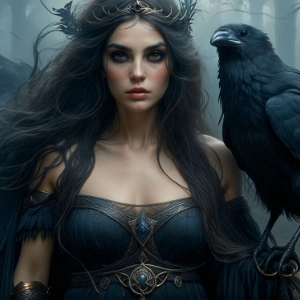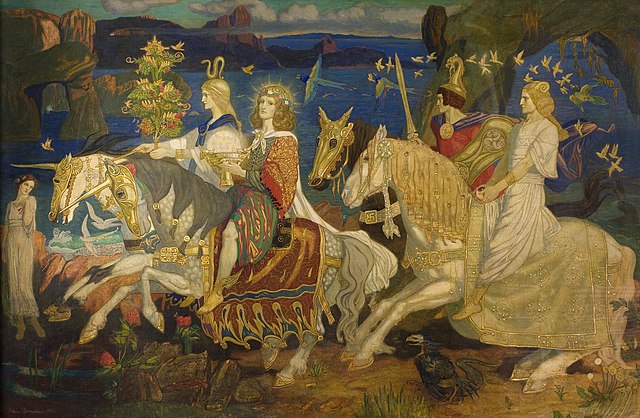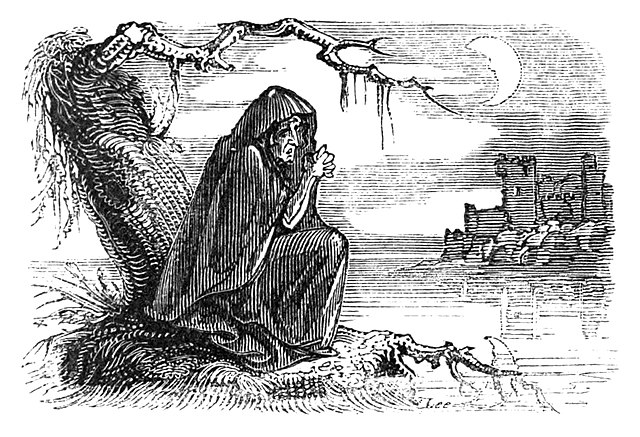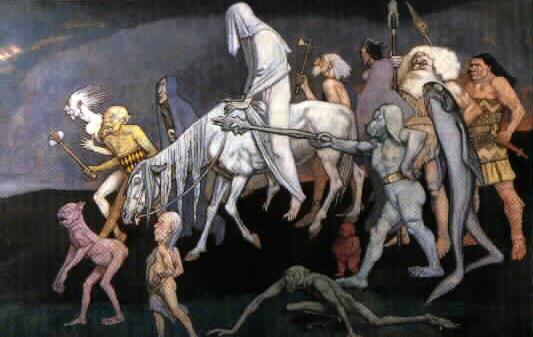Who is the Morrígan: Ireland’s Phantom Queen of War, Fate & Sovereignty
Irish mythology is filled with ancient stories of gods, heroes, and magical beings that have shaped Ireland’s cultural heritage for centuries. These tales give us a glimpse into how the Irish viewed the world, the forces of nature, and the mysteries of life and death. The gods of Irish lore, known as the Tuatha Dé Danann, are powerful and complex figures who ruled over the land, sky, and sea, each with distinct powers and personalities.
One of the most fascinating and mysterious figures in this mythology is the Morrígan. Often referred to as the “Phantom Queen” or “Great Queen,” the Morrígan is a goddess of war, fate, and sovereignty. She can influence the outcome of battles, foretell the fates of warriors, and even guide the souls of the dead. Her presence is felt in times of chaos and transformation, making her both a feared and revered figure.
Understanding Morrígan’s role in Irish mythology helps us explore deeper themes of life, death, and power. She represents the unpredictable forces of war and the idea of sovereignty—the right to rule and protect the land. By delving into her stories, we gain insights into Irish culture and heritage, where life and death are seen as interconnected forces and the balance of power is constantly in flux.
The Morrígan’s story is one of destiny, transformation, and the timeless cycle of creation and destruction, reminding us of the delicate dance between life and death.
Table of Contents
Who is the Morrígan?

The Morrígan is one of Irish mythology’s most influential and mysterious goddesses. Her name is often interpreted as “Phantom Queen” or “Great Queen,” she holds an important place in Irish lore because of her connection to war, prophecy, and sovereignty. As a goddess, the Morrígan can influence the outcome of battles and the fate of warriors. She can appear on the battlefield as a crow, signalling death and destruction, or take on other forms to shape events.
What makes the Morrígan so significant is her association with war and her role as a goddess of prophecy. She can foresee the future and often delivers prophecies about heroes’ fates, sometimes appearing to them before great battles. In this way, she plays a vital role in the lives and deaths of warriors, influencing their destinies.
The Morrígan is also closely tied to the concept of sovereignty. In Irish mythology, she is connected to the right to rule; her approval or blessing can determine who becomes king. She represents the land and the forces of nature that sustain or challenge rulers, making her a goddess of war and a protector of the land and its people.
Her role as a goddess of war, prophecy, and sovereignty gives her a unique and powerful place in Irish mythology. She embodies both the chaotic forces of battle and the stabilising power of legitimate rule, making her one of the most influential figures in Irish culture and storytelling.
The Triple Goddess: The Morrígan’s Multiple Aspects
The Morrígan is often described as a triple goddess, which means she is sometimes represented as three different figures rather than just one. These three figures are typically the Morrígan herself, along with two other goddesses named Badb and Macha. Together, they form a powerful trio representing life, death, and battle.
Each of these three goddesses has her own role to play. The Morrígan can influence war and destiny. At the same time, Badb is closely linked to death and destruction, often appearing in the form of a crow on battlefields. On the other hand, Macha is connected to kingship and the protection of the land. This triad shows that the Morrígan isn’t just about war but also about the natural cycles of life and death and the balance of power.
The three forms of the Morrígan symbolize the cyclical nature of existence. Life is full of beginnings, endings, and transformations, like the cycle of birth, death, and rebirth. The Morrígan, as a triple goddess, embodies this idea, showing that destruction (like in battle) is often followed by new growth and that death is just one part of the larger cycle of life.
In this way, the Morrígan’s multiple aspects reflect life’s constant ebb and flow. She is not just a goddess of war but a force of nature that guides the ongoing cycle of creation and destruction. By understanding her three forms, we can see how Irish mythology views life as interconnected and always moving forward, even through moments of chaos and change.
The Morrigan: Goddess of War and Fate

The Morrígan is best known as a goddess of war and fate. She is often present on battlefields, not as a warrior but as a powerful force influencing the outcome of fights. Her connection to war is not about direct combat but about guiding the destiny of warriors and determining who will live and who will die. She is believed to be able to control the tide of battle and bring destruction where needed.
One of the Morrígan’s most striking features is her ability to appear as a crow, known as Badb Catha, or the “battle crow.” When she takes this form, it usually signals doom and death. Warriors who see the Morrígan as a crow on the battlefield know that danger and loss are near. In this way, she serves as a warning of what is to come, and her appearance can affect the morale and fate of those fighting.
One of the most famous stories involving the Morrígan is her interaction with the great Irish hero, Cú Chulainn, in the epic tale Táin Bó Cúailnge (The Cattle Raid of Cooley). In the story, the Morrígan appears to Cú Chulainn in different forms, testing him and trying to distract him from battle. She first approaches him as a beautiful woman offering love and protection. Still, when he rejects her, she shapeshifts into different animals—a bird, an eel, and a wolf—to hinder him in battle.
Despite her attempts to throw him off, Cú Chulainn fights bravely. Later, after a brutal battle, she reappears to him, disguised as an old woman. This time, she offers him a drink of milk, and he unknowingly heals her, showing the complexity of their relationship. The Morrígan ultimately foretells Cú Chulainn’s death, reminding us that she is not just a goddess of war but also a figure who controls the fate of even the mightiest warriors.
The Morrígan shows her deep connection to war and destiny through stories like these. She appears to guide battles and the fates of those fighting, her prophecies shaping the outcome of conflicts and lives. Whether in the form of a crow, an old woman, or a shapeshifting goddess, the Morrígan always remains in control, reminding warriors of the thin line between life and death.
The Morrígan: The Shapeshifting Goddess

One of the Morrígan’s most unique and powerful abilities is her talent for shapeshifting. She can take on many forms, appearing as a crow, a wolf, an eel, or even a beautiful woman. This ability to transform reflects her control over fate and change. In Irish mythology, shapeshifting is often linked to transformation—just as people, events, or battles can change instantly, so can the Morrígan. Her shifting forms represent the unpredictable nature of life and the constant movement between life, death, and rebirth.
The Morrígan’s shapeshifting also gives her the power to test or deceive those she interacts with. In some stories, she transforms to challenge a warrior or trick them into making decisions that will affect their fate. By changing her appearance, the Morrígan reminds us that nothing is fixed and that fate can shift as quickly as she does.
The Morrígan’s shapeshifting abilities highlight her role as a goddess of transformation. By changing her form, she demonstrates that nothing in life is permanent. Her dominion over fate and her power to influence events remind us that life, like her many shapes, is ever-changing, and we are all subject to the forces of transformation.
The Morrígan: Sovereignty and Kingship
In Irish mythology, the Morrígan is not just a goddess of war and fate—she also plays a vital role in the concept of sovereignty, which is the right to rule and protect the land. The Morrígan has a deep connection to the land itself, and her favour is essential for the prosperity of the kingdom. She is often seen as the protector of Ireland, and her approval or blessing can determine who is fit to rule as king.
One way the Morrígan interacts with kings is by testing them. She may appear to challenge a king’s strength, wisdom, or character in different forms. If the king passes her test, it shows that he is worthy to rule and has the goddess’s support. In this way, the Morrígan acts as a guardian of the land, ensuring that only those who can truly protect and care for it will hold power.
In some stories, the Morrígan grants her favour to rightful rulers by appearing to them and forming a union. This symbolic act, known as the “sacred marriage,” represents the king’s connection to the land and his duty to protect it. When the king has the Morrígan’s blessing, it ensures that the land will prosper, crops will grow, and peace will be maintained. The relationship between the king and the Morrígan reflects the ancient belief that the land’s health is tied to its ruler’s strength and virtue.
The Morrígan’s role in sovereignty is more than just about kingship—it’s about the balance between power and the land. She represents the forces of nature and life cycles, and her influence ensures that rulers respect the land and fulfil their responsibilities. If a king fails or proves unworthy, the Morrígan may withdraw her favour, leading to chaos, destruction, or the kingdom’s downfall.
Through her relationship with the land and her role in granting or testing rulers, the Morrígan shows that sovereignty is a delicate balance. It’s not just about ruling but about understanding and respecting the forces of nature that sustain life. The Morrígan’s presence reminds us that prosperity depends on wise leadership and a deep connection to the land.
The Morrígan’s Role in the Battle of Mag Tuired

The Second Battle of Mag Tuired is one of the most important events in Irish mythology. This battle was fought between the Tuatha Dé Danann, the gods of Ireland, and the Fomorians, a race of powerful, destructive beings who wanted to control the land. The Tuatha Dé Danann, led by their king, Nuada, fought to defend Ireland from the harsh rule of the Fomorians, led by their brutal king, Balor.
The Morrígan played a crucial role in this epic battle, using her powers of prophecy and destruction to help the Tuatha Dé Danann defeat their enemies. Before the battle began, the Morrígan gave powerful prophecies, predicting the fight’s outcome. Her foresight encouraged the Tuatha Dé Danann, filling them with confidence and strength as they prepared to face the Fomorians.
The Morrígan unleashed her destructive powers during the battle, turning the tide in favour of the Tuatha Dé Danann. She used magic to strike fear into the hearts of the Fomorians, spreading confusion and chaos among their ranks. In some versions of the story, she transforms into her crow form. She flies over the battlefield, signalling the death of the Fomorian warriors. Her presence brought destruction and ensured the defeat of the Fomorians.
After the Tuatha Dé Danann’s victory, the Morrígan delivered a chilling prophecy about the future. She foretold the eventual end of the world, describing a time when chaos and destruction would return and the natural order would collapse. Her prophecy speaks of rivers of blood, darkness covering the land, and the breakdown of society. This grim vision serves as a reminder that even in times of victory, the forces of destruction are never far away.
The Morrígan’s role in the Battle of Mag Tuired highlights her immense power and connection to war and prophecy. She is not only a goddess who brings destruction but also one who sees the future and guides the fate of nations. Her final prophecy after the battle serves as a reminder that the cycle of life, death, and chaos is ongoing and that no victory is permanent.
The Morrígan’s Connection to the Otherworld
The Morrígan holds a special place in Irish mythology as a goddess who bridges the mortal realm and the Otherworld, a mystical place where the dead reside and time differ. This connection makes her an influential figure, as she can influence both the living and the dead.
As a guide for souls, the Morrígan helps lead those who have died to the Otherworld. When warriors fall in battle, she is often there to collect their souls and ensure they find peace. Her presence provides comfort, showing that death is not an end but a transition to another existence. This role as a guide emphasizes her deep understanding of life and death and the cycles that connect them.
The Morrígan’s influence extends beyond just guiding souls. She also affects the fate of the living, often foretelling their destinies through prophecies. By knowing the future, she can help warriors make choices that align with their fates, either leading them to glory or warning them of impending doom. This duality reflects her power over creation and destruction, as her insights can shape lives and events.
Symbolically, the Morrígan embodies the balance between life and death. She represents the idea that both are necessary for the world to continue. Just as life brings growth and vitality, death is essential for renewal and transformation. The Morrígan’s role as a goddess of the Otherworld highlights this connection, reminding us that creation and destruction are part of the same cycle.
In this way, the Morrígan stands as an influential figure in Irish mythology, bridging the gap between the living and the dead. She teaches us that life is a journey filled with changes and that death, while often feared, is another step. Her presence in both realms reminds us of the interconnectedness of all things and the eternal cycle of existence.
Symbols of the Morrígan
The Morrígan is associated with several powerful symbols reflecting her nature and her roles in Irish mythology. Each symbol carries a deep meaning and helps us understand her significance.
The Crow/Raven
One of the most prominent symbols of the Morrígan is the crow or raven. This bird is often seen as a symbol of prophecy, death, and battle. When the Morrígan appears as a crow, it usually signals that danger is near or death is coming. Her presence on the battlefield serves as a warning to warriors, reminding them that she is watching and influencing their fates. The crow embodies her connection to the dark, mysterious aspects of life and her ability to see beyond the ordinary into the realm of the unknown.
Wolves
Wolves are another vital symbol associated with the Morrígan. They represent her connection to the wild forces of nature and the untamed aspects of life. In many stories, wolves embody strength, loyalty, and the instinctive side of existence. The Morrígan’s association with wolves highlights her role as a fierce protector and a guide in the natural world. It reflects her ability to balance life and death, showing her in tune with the primal forces that govern the universe.
Cattle
Cattle also hold significant meaning in the mythology surrounding the Morrígan. They symbolize wealth, power, and fertility. They are often central to many vital stories in Irish lore, such as cattle raids. The Morrígan’s presence indicates her influence over prosperity and abundance in these tales. Cattle represent the land’s resources and the strength of a kingdom. When the Morrígan is involved, it often signifies the connection between a ruler’s power and the land’s health.
These symbols—the crow, wolves, and cattle—help us understand Morrígan’s multifaceted nature. They reflect her roles as a goddess of prophecy and battle, a guardian of the natural world, and a protector of the land’s wealth and resources. Through these symbols, the Morrígan embodies the complex interplay of life, death, and the forces that shape our existence.
Conclusion
The Morrígan is one of Irish mythology’s most potent and complex figures. As a goddess of war, fate, and sovereignty, her influence goes far beyond the battlefield. She plays a crucial role in shaping the destinies of kings and warriors, guiding them through the challenges of life and death. Her ability to see the future and her connection to the natural cycles of existence remind us that life is a journey filled with transformation and balance.
Through her many forms and symbols, the Morrígan represents the intertwined nature of creation and destruction, and her presence serves as a reminder that every ending can lead to a new beginning. Her story continues to resonate in Irish culture, reflecting the timeless themes of power, destiny, and the connection between the living and the dead.
We encourage you to delve deeper into Irish mythology and explore the rich tapestry of stories surrounding the Morrígan and other fascinating figures. By doing so, you’ll gain a greater appreciation for Ireland’s cultural heritage and the enduring legacy of its myths, which continue to inspire and captivate people today. The Morrígan’s tale is just one of many that illustrate the beauty and complexity of Irish folklore, inviting us all to reflect on the cycles of life and the powerful forces that shape our world.
Recommended Reading:
- Irish Mythology: Gods and Goddesses
- The Tuatha Dé Dannan
- The Fomorians
- The Fir Bolg
- The Great God Dagda
- Lugh of the Long Arm
- Irish Sea God: Manannán Mac Lir
Recommended Books:
Irish Mythology: Enthralling Myths, Folktales, and Legends of Gods, Goddesses, and Mythological Creatures of Ancient Ireland by Billy Wellman
Who is the Morrígan in Irish mythology?
The Morrígan is a powerful goddess in Irish mythology associated with war, fate, and sovereignty. Often called the Phantom Queen or Great Queen, she is known for foretelling death and doom on the battlefield. She plays a key role in major mythological tales, including the battles of the Tuatha Dé Danann, and is linked to shapeshifting, prophecy, and the Otherworld.
Is the Morrígan a triple goddess?
Yes, the Morrígan is often considered a triple goddess, meaning she appears as three aspects of the same divine figure. These aspects are typically named Badb, Macha, and Nemain, each representing different facets of war, destruction, and fate. In some myths, the Morrígan merges all three identities into one powerful entity, reinforcing her role as a complex and formidable goddess.
What is the Morrígan’s role in battle?
The Morrígan is a war goddess who influences battles through prophecy, shapeshifting, and psychological warfare. She appears before conflicts to foretell the outcome, sometimes instilling fear and confusion in enemies. She also takes the form of a raven or crow, symbolizing death and watching over the battlefield. Her presence ensures the victory of her chosen warriors while marking others for doom.
